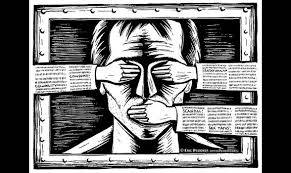The term ‘freedom of speech’ has an innately positive ring to it. For, it simply means letting people express what they might want to say.
This is why adherents of the most suppressive of ideologies, and upholders of the most autocratic of regimes, would never overtly denounce the freedom to say things. Some of them might even self-identify as torchbearers of this very right.
Unlike secularism or liberalism – so often the butt of contempt from conservatists – ‘freedom of speech’ is wholeheartedly embraced by all. Only that most of these clasps to bosoms are dedicated to self-conveniently chiseled sculptures of free speech, which is usually hammered into incognito mode.
This perversion of freedom of speech into acceptability, as approved by the status quo, is performed through long-bladed asterisks. The beveled cutting-edge of these asterisks gives the final shape, and outlines the exceptions. This asterisk is the kryptonite to the simultaneously carved out concept of free speech.
The asterisk is anything that follows but in the following sentence: “We support freedom of speech but…” Its clout and utility can be gauged by the fact that this but is often used in the immediate aftermath of cartoonists being murdered, journalists being attacked, activists being silenced, or bloggers being abducted for exercising their right to free speech.
This asterisk, in turn, is founded upon the idea of ‘offensiveness’. The threshold of a sufficient number of people, or those with the power to harm, defines the shackles of free speech.
But is there any freedom if one can’t express ideas that could be found disagreeable or even downright repulsive? What is freedom of speech if not the right to offend?
Would there be freedom to own property, if homelessness was the only alternative to not using that land a certain way?
Would one have the right to life, if not living as dictated was punishable by death?
Would there be right to equality (Article 1 of the Universal Declaration of Human Rights) if citizens were categorised as more and less equal?
The only way people can exercise ‘freedom’ of speech to never offend anyone is if everyone thought identically and agreed with the same ideas. That, in turn, is only possible if thinking itself is a centripetal process, regulated by a unitary authority.
Even so, unlike land, homelessness, life, death and equality, ‘offend’ is a subjective word – although some might say the same about equality, in the increasingly Orwellian world that we live in.
This is why the definition of ‘offensive’ – the magnitude of the aforementioned asterisk – outlines the limits to free speech. And any totalitarian attempts at the definition are usually coupled with ‘glory of X’, ‘in the best interests of Y’ or ‘sentiments of Z’.
As you might have noticed, a wide array of vague concepts is used to concisely interpret an abstract idea. The vaguer they are, the more restrictively they can be interpreted.
But can there really be absolute freedom of speech? Because that would include the right to urge others to kill someone – or the right to catcall at women one works with – or even the right to tweet the country’s nuclear codes.
There are contracts that limit these freedoms. The one that citizens have with the state is a social contract, designed to optimise the collective benefit. Hence, the asterisks on free speech devised by the state should keep the interests of its people, as a whole, in mind.
The interests of the people cannot be defined through belief-systems and ideologies and their interpretations. There is enough empirical evidence that can be studied, putting quality of life as the benchmark, to figure out state intervention in streamlining freedom and rights.
The right to nationality, for instance, is dependent on birth, residence, etc. The right to ‘free movement in and out of country’ is governed by visas.
How then should free speech be regulated such that it doesn’t infringe upon the freedom of another individual? This, after all, is paraphrasing the much cited definition of ‘freedom’ attributed to Oliver Wendell Holmes Jr., among many others.
Any expression that can be interpreted as hate speech and/or harassment obviously negatively impacts other individual(s). Now how do we concisely define ‘hate speech’ for instance? Isn’t critiquing or mocking an ideology – or an institution – that a group of people hold dear, hate speech?
Back to square one.
Hate speech should be defined as inciting violence against an individual or a group of people. For, that is the only source of tangible harm. There is no gauge yet to measure sentiments, hence their superfluity in empiricism.
So is it a result of ‘hate speech’ when people burn their properties or attack others for cartoons, articles, videos and beliefs? Isn’t it violence caused by someone’s expression? Should these be banned then?
The ‘blasphemous’ cartoon doesn’t cause violence. The idea that someone should be killed for sketching, portraying and saying something, does – and that, therefore, should qualify as a hate speech asterisk.
It is the asterisks on free speech that define the nature of a state. When religion or nationalism is used to define free speech the tool carving the boundary out becomes sharper. And the sharper the mallet, the smaller the final sculpture of freedom of speech is.






